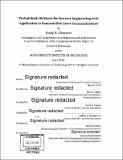Probabilistic methods for systems engineering with application to nanosatellite laser communications
Author(s)
Clements, Emily Baker
DownloadFull printable version (13.79Mb)
Other Contributors
Massachusetts Institute of Technology. Department of Aeronautics and Astronautics.
Advisor
Kerri L. Cahoy.
Terms of use
Metadata
Show full item recordAbstract
Risk-tolerant platforms such as nanosatellites may be able to accept moderate performance uncertainty if it enables the reduction of cost or improves manufacturability, in contrast to large-budget space missions. New uncertainty-based systems engineering approaches such as uncertainty-based multidisciplinary optimization require the use of integrated performance models with input distributions, which do not yet exist for complex systems, e.g. laser communications (lasercom) payloads. In this thesis, we present our development of a statistical, risk-tolerant systems engineering approach and apply it to nanosatellite-based design and architecture problems to investigate whether adding a statistical element to systems engineering enables improvements in performance, manufacturability, and cost. The scope of this work is restricted to a subset of nanosatellite-based lasercom systems, which are particularly useful given current momentum to field Earth observing nanosatellite constellations and challenges for data retrieval. We build uncertainty-based lasercom performance models for a low Earth orbiting (LEO) system being developed at MIT called the Nanosatellite Optical Downlink Experiment (NODE) as a reference architecture. Compared with a more traditional, deterministic systems engineering approach, we find our probabilistic approach leads to a lasercom downlink design with a 59% reduction in ground station diameter and a 46% reduction in space terminal power for equivalent probabilities of a LEO-ground system delivering 500 Gb/day. We compare the data volume and latency performance of five communication architectures for nanosatellite constellations with and without lasercom crosslinks: two ground stations vs. nine ground stations with (i and ii) lasercom and (iii and iv) X-band, and (v) UHF with one ground station. For example, we find that a 30-satellite Walker delta constellation of 6U satellites with an optical downlink to nine ground stations and optical crosslinks can achieve a similar data volume and latency to the large X-band network with no crosslinks, with a higher than 90% chance of achieving 7.5 Tb/day and less than 2 hour latency for high-priority data, at two-thirds the cost. While we focus on a nanosatellite lasercom application, the process for characterizing the input distributions and modeling performance is generalizable to other lasercom systems or space systems.
Description
Thesis: Ph. D., Massachusetts Institute of Technology, Department of Aeronautics and Astronautics, 2018. Cataloged from PDF version of thesis. Includes bibliographical references (pages 109-121).
Date issued
2018Department
Massachusetts Institute of Technology. Department of Aeronautics and AstronauticsPublisher
Massachusetts Institute of Technology
Keywords
Aeronautics and Astronautics.